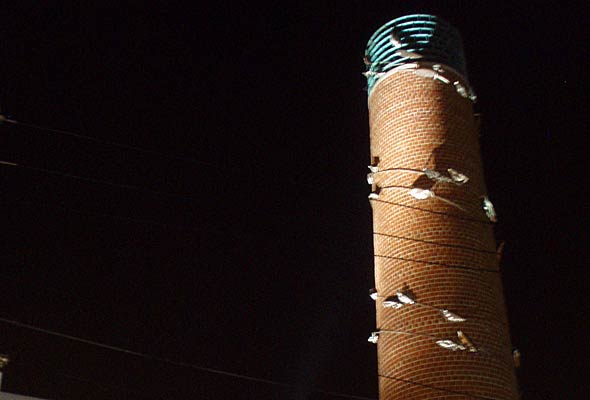
From the Providence Journal Editorials
The Smokestack as Civic Virtue
By DAVID BRUSSAT | 01:00 AM EDT on Thursday, July 13, 2006
How perfectly organic. A steel vine climbs up a brick smokestack. The smokestack rises from an old factory newly renamed The Plant, amid the detritus of the flower of the city's former industrial wealth. The smokestack says: The community will rise again, and the people will flourish.
Simple, yet meaningful. Symbolism doesn't get much better than that. Neither does public art.
The only major smokestack that remains at the former Providence Dyeing, Bleaching & Calendaring Co. (c. 1843), on Valley Street, in Olneyville, was clobbered by a storm in the 1990s, toppling all but 60 feet of stack. The factory had preceded the stack into hard times decades before, along with much of the rest of industrial Providence. The city's decline during the middle of the 20th Century dragged Olneyville down. Once a robust mix of mills, mill workers and shops serving mill workers, it is now considered the poorest district in town.
Last year, Providence artist Gillian Christy took the job of falling in love with the unhappy smokestack. Well, perhaps that's too romantic a description of applying for a grant to turn the crippled relic into a work of art as part of a mill-rehab venture. The Plant is a mixture of artist live/work lofts and galleries being developed by the community nonprofit group Puente and mill-rehabilitation specialist Struever Bros., Eccles & Rouse, of Baltimore.
Nevertheless, the Davenport, Iowa, native has turned the stack's rehabilitation into a labor of love, into which she has drawn the local community.
Yesterday, at the Peerless Lofts, in downtown, a fundraiser was held to encourage the part of the local community with money to spend $30 to $360 for the greater good, or at any rate to metaphorically buy a brick for the stack. ("Bricks" are still available. Contact Puente at 401/454-3570.)
Another part of the community, even more local, was drawn even more intimately into the project by Christy. She taught a metalworking course at the Steel Yard, a nonprofit in the Promenade District that offers arts and technical training, and incubates artful businesses. She invited a class from the Met School and a group of neighborhood residents to fabricate the stainless-steel leaves that are to be attached to the vine that snakes up the smokestack.
When the vine reaches the lip of the remaining part of the smokestack, it will rise 10 feet farther to embrace an extension of the stack in bronze, which will replicate the grout pattern of the stack's original brickwork. In short, the old will be new, linked by nature in the form of the vine. Thus will the community hold hands across the bridge to the future of the city. ("Puente" means bridge in Spanish.)
The actual implantation of the art atop the smokestack should be an entertaining affair when it occurs, possibly in September. Turning it into a party might help further bridge relations between The Plant's proponents and the community.
The Smokestack symbolizes the continuing rebirth of Olneyville. Some criticize "gentrification," but if poor neighborhoods are left to fester, that is criticized, too. Yet The Plant, the Steel Yard, Puente, Struever Bros., the Armory Revival Co. and others – including a growing set of nonprofits building affordable (and attractive!) housing – seem to be trying to bridge the gap between revitalization and stagnation without alienating even those who insist upon – indeed, revel in – their alienation.
It isn't easy, and it seems that no good deed goes unpunished. The symbol of community emerging from The Smokestack cannot come too soon.
Readers may not realize they are familiar with the work of Gillian Christy. Her Winding Walk sits near the ice rink downtown. A column of stainless steel nine feet tall with a tiny staircase winding up its length, eventually reaching a room with shutters thrown open, revealing a boat, Winding Walk has that legible whimsicality that charms passersby who, I would guess, are merely baffled by other nearby sculpture. Take, for example, the several sculptures formed (?) of oddly shaped metal pieces, signifying (apparently) nothing. If more civic sculpture were of the Winding Walk school, and less of it were of the Junk Thrown Together by Children school, public art would not be such an easy target.


